As contemporary society delves further into the Digital Age, technological devices and digital systems and programs become more and more integral to the transfer of knowledge and information. So integrated are these digital interfaces that some privileged classes of youth may no longer remember or have had the experience of learning in an environment that is completely “unplugged”. Whether they possess full or partial access to digital learning, it is important that all students understand the processes by which they can both effectively and safely utilize technology and digital interfaces. The books featured in this post will help teachers, guardians, and educational administrators do just that.
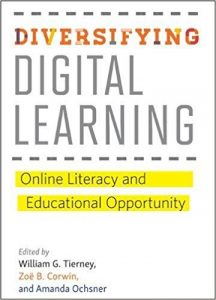 The first item on spotlight is Diversifying Digital Learning: Online Literacy and Educational Opportunity edited by William G. Tierney, Zoë B. Corwin, and Amanda Ochsner. This book explores the issues surrounding what is called the “digital divide”; a phenomenon that pertains to the circumstances by which some demographics of students are privileged and thus empowered through access to digital and technological resources, while others are not. Diversifying Digital Learning explores the ways that this divide perpetuates digital illiteracy and thus further disempowers those communities who do not possess access to those resources. While also highlighting the various ways that demographics like women and people of colour are uniquely disadvantaged by this system, this item acts as a great resource in understanding the complications involved in erasing the digital divide while still offering some possible solutions.
The first item on spotlight is Diversifying Digital Learning: Online Literacy and Educational Opportunity edited by William G. Tierney, Zoë B. Corwin, and Amanda Ochsner. This book explores the issues surrounding what is called the “digital divide”; a phenomenon that pertains to the circumstances by which some demographics of students are privileged and thus empowered through access to digital and technological resources, while others are not. Diversifying Digital Learning explores the ways that this divide perpetuates digital illiteracy and thus further disempowers those communities who do not possess access to those resources. While also highlighting the various ways that demographics like women and people of colour are uniquely disadvantaged by this system, this item acts as a great resource in understanding the complications involved in erasing the digital divide while still offering some possible solutions.
Game On! Gamification, Gameful Design, and the Rise of the Gamer Educator works to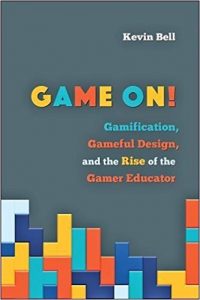 revolutionize the very way that classrooms are designed and structured. Taking its inspiration from video games and social media, this item works to explore the classroom that offers a more personalized, interactive, and inclusive environment that mirrors the student experience when they engage with the digital world. Placing heavy emphasis on creativity and engagement, the type of classroom promoted in this book privileges an environment where the student is involved and interested in their own education. By outlining the ways that this type of engagement can empower students, particularly high-risk youth, Game On! offers the unique opportunity of observing and understanding a learning environment more in-tune with the desires and needs of contemporary youth in the Digital Age.
revolutionize the very way that classrooms are designed and structured. Taking its inspiration from video games and social media, this item works to explore the classroom that offers a more personalized, interactive, and inclusive environment that mirrors the student experience when they engage with the digital world. Placing heavy emphasis on creativity and engagement, the type of classroom promoted in this book privileges an environment where the student is involved and interested in their own education. By outlining the ways that this type of engagement can empower students, particularly high-risk youth, Game On! offers the unique opportunity of observing and understanding a learning environment more in-tune with the desires and needs of contemporary youth in the Digital Age.
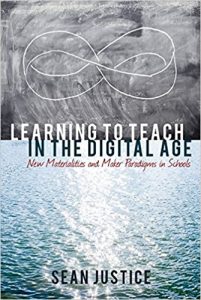 Similar in its recognition of the transformative nature of digital learning, Learning to teach in the Digital Age: New Materialities and Maker Paradigms in Schools explores and evaluates the many ways that the inclusion of technology in classrooms and lesson-plans inevitably works to transform the very conceptualization and foundation of education. The content of this book follows author Sean Justice, who attends a girls private school in the northeastern United States to observe the effects technology has in the classroom, and the ways that students, educators, and education administrators interact with them. In the end, Justice claims that the findings suggest that digital learning can be successfully integrated into the classroom, and can be done so in innovative and creative ways.
Similar in its recognition of the transformative nature of digital learning, Learning to teach in the Digital Age: New Materialities and Maker Paradigms in Schools explores and evaluates the many ways that the inclusion of technology in classrooms and lesson-plans inevitably works to transform the very conceptualization and foundation of education. The content of this book follows author Sean Justice, who attends a girls private school in the northeastern United States to observe the effects technology has in the classroom, and the ways that students, educators, and education administrators interact with them. In the end, Justice claims that the findings suggest that digital learning can be successfully integrated into the classroom, and can be done so in innovative and creative ways.
Digital Technologies in Early Childhood Art: Enabling Playful Experiences is the book for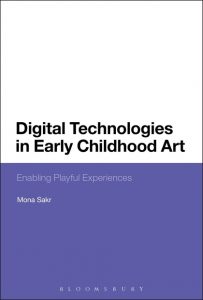 the guardian or educator who feels weary when considering the many ways that digital technologies are affecting the growth and development of young students, and specifically, the development of their creativity. In her book, Mona Sakr discusses the positive effects of art-making like drawing, painting, and modelling have on youth, and the many ways that such activities and their effects can be adopted onto a digital platform. By offering a number of recommendations on how youth can creatively engage with art-making processes online, Sakr demonstrates the positive ways that digital technology can help inform and shape the cornerstone moments and experiences in a child’s development.
the guardian or educator who feels weary when considering the many ways that digital technologies are affecting the growth and development of young students, and specifically, the development of their creativity. In her book, Mona Sakr discusses the positive effects of art-making like drawing, painting, and modelling have on youth, and the many ways that such activities and their effects can be adopted onto a digital platform. By offering a number of recommendations on how youth can creatively engage with art-making processes online, Sakr demonstrates the positive ways that digital technology can help inform and shape the cornerstone moments and experiences in a child’s development.
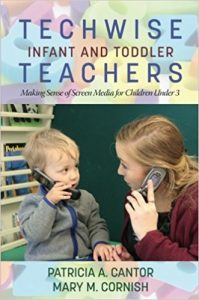 Another book that touches upon the role that technology has on children’s development, Techwise Infant and Toddler Teachers: Making Sense of Screen Media for Children under 3 explores the relationship between screen media and children under three years of age. This item explores the role that screen media has in the education of toddlers, and offers guidance in making that role appropriate and productive. With a heavy emphasis on educating toddlers in becoming proficient and responsible in their interaction with screen media, this book sets the stage for guardians, educators and education administrators to inform and empower toddlers in becoming “techwise”, or rather, digitally literate.
Another book that touches upon the role that technology has on children’s development, Techwise Infant and Toddler Teachers: Making Sense of Screen Media for Children under 3 explores the relationship between screen media and children under three years of age. This item explores the role that screen media has in the education of toddlers, and offers guidance in making that role appropriate and productive. With a heavy emphasis on educating toddlers in becoming proficient and responsible in their interaction with screen media, this book sets the stage for guardians, educators and education administrators to inform and empower toddlers in becoming “techwise”, or rather, digitally literate.
For these and more books on teaching in the Digital Age, visit the Lobby Display on the ground floor of the OISE building. Please feel free to take out the materials found in the lobby display—OISE staff would be happy to take these out for you.
